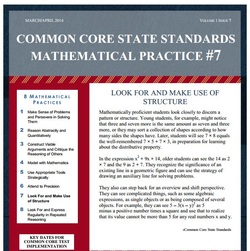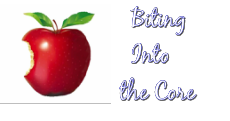SMP #7 Look for & Make Use of Structure
The North Carolina Unpacked Standards provide a summary statement about the SMPs for each grade level:
Kindergarten: Mathematically proficient students in Kindergarten carefully look for patterns and structures in the number system and other areas of mathematics. While solving addition problems, students begin to recognize the commutative property, in that 1+4 = 5, and 4+1 = 5. While decomposing teen numbers, students realize that every number between 11 and 19, can be decomposed into 10 and some leftovers, such as 12 = 10+2, 13 = 10+3, etc. Further, Kindergarten students make use of structures of mathematical tasks when they begin to work with subtraction as missing addend problems, such as 5- 1 = __ can be written as 1+ __ = 5 and can be thought of as how much more do I need to add to 1 to get to 5?
1st Grade: Mathematically proficient students in Grade 1 carefully look for patterns and structures in the number system and other areas of mathematics. While solving addition problems, students begin to recognize the commutative property, in that 7+4 = 11, and 4+7 = 11. While decomposing two-digit numbers, students realize that any two-digit number can be broken up into tens and ones, e.g. 35 = 30 + 5, 76 = 70+6. Further, Grade 1 students make use of structure when they work with subtraction as missing addend problems, such as 13- 7 = __ can be written as 7+ __ = 13 and can be thought of as how much more do I need to add to 7 to get to 13?
2nd Grade: Mathematically proficient students in Grade 2 carefully look for patterns and structures in the number system and other areas of mathematics. While solving addition and subtraction problems students can apply the patterns of the number system to skip count by 10s off the decade. For example, Grade 2 students are expected to mentally reason that 33 + 21 is 33 plus 2 tens, which equals 53 and then an addition one which equals 54. While working in the Numbers in Base Ten domain, students work with the idea that 10 ones equals a ten, and 10 tens equals 1 hundred. Further, Grade 2 students also make use of structure when they work with subtraction as missing addend problems, such as 50- 33 = __ can be written as 33+ __ = 50 and can be thought of as how much more do I need to add to 33 to get to 50?
3rd Grade: Mathematically proficient students in Grade 3 look closely to discover a pattern or structure. For instance, students use properties of operations as strategies to multiply and divide (commutative and distributive properties).
4th Grade: Mathematically proficient students in Grade 4 closely examine numbers to discover a pattern or structure. For instance, students use properties of operations to explain calculations (partial products model). They relate representations of counting problems such as tree diagrams and arrays to the multiplication principal of counting. They generate number or shape patterns that follow a given rule.
5th Grade: Mathematically proficient students in Grade 5 look closely to discover a pattern or structure. For instance, students use properties of operations as strategies to add, subtract, multiply and divide with whole numbers, fractions, and decimals. They examine numerical patterns and relate them to a rule or a graphical representation.
InsideMathematics has video examples of SMP #7 in lessons from 4th and 5th grade classrooms.
Thinkmath.edc.org has a discussion about SMP#7 as does Wisconsin.
Here's a Teaching Channel video which targets SMP#7.
Kindergarten: Mathematically proficient students in Kindergarten carefully look for patterns and structures in the number system and other areas of mathematics. While solving addition problems, students begin to recognize the commutative property, in that 1+4 = 5, and 4+1 = 5. While decomposing teen numbers, students realize that every number between 11 and 19, can be decomposed into 10 and some leftovers, such as 12 = 10+2, 13 = 10+3, etc. Further, Kindergarten students make use of structures of mathematical tasks when they begin to work with subtraction as missing addend problems, such as 5- 1 = __ can be written as 1+ __ = 5 and can be thought of as how much more do I need to add to 1 to get to 5?
1st Grade: Mathematically proficient students in Grade 1 carefully look for patterns and structures in the number system and other areas of mathematics. While solving addition problems, students begin to recognize the commutative property, in that 7+4 = 11, and 4+7 = 11. While decomposing two-digit numbers, students realize that any two-digit number can be broken up into tens and ones, e.g. 35 = 30 + 5, 76 = 70+6. Further, Grade 1 students make use of structure when they work with subtraction as missing addend problems, such as 13- 7 = __ can be written as 7+ __ = 13 and can be thought of as how much more do I need to add to 7 to get to 13?
2nd Grade: Mathematically proficient students in Grade 2 carefully look for patterns and structures in the number system and other areas of mathematics. While solving addition and subtraction problems students can apply the patterns of the number system to skip count by 10s off the decade. For example, Grade 2 students are expected to mentally reason that 33 + 21 is 33 plus 2 tens, which equals 53 and then an addition one which equals 54. While working in the Numbers in Base Ten domain, students work with the idea that 10 ones equals a ten, and 10 tens equals 1 hundred. Further, Grade 2 students also make use of structure when they work with subtraction as missing addend problems, such as 50- 33 = __ can be written as 33+ __ = 50 and can be thought of as how much more do I need to add to 33 to get to 50?
3rd Grade: Mathematically proficient students in Grade 3 look closely to discover a pattern or structure. For instance, students use properties of operations as strategies to multiply and divide (commutative and distributive properties).
4th Grade: Mathematically proficient students in Grade 4 closely examine numbers to discover a pattern or structure. For instance, students use properties of operations to explain calculations (partial products model). They relate representations of counting problems such as tree diagrams and arrays to the multiplication principal of counting. They generate number or shape patterns that follow a given rule.
5th Grade: Mathematically proficient students in Grade 5 look closely to discover a pattern or structure. For instance, students use properties of operations as strategies to add, subtract, multiply and divide with whole numbers, fractions, and decimals. They examine numerical patterns and relate them to a rule or a graphical representation.
InsideMathematics has video examples of SMP #7 in lessons from 4th and 5th grade classrooms.
Thinkmath.edc.org has a discussion about SMP#7 as does Wisconsin.
Here's a Teaching Channel video which targets SMP#7.

Noristown Unified School District in Pennsylvania has published some outstanding newsletters which focus on each of the Standards for Mathematical Practice. SMP Newsletter #7 can be found here.


